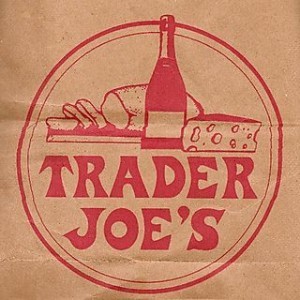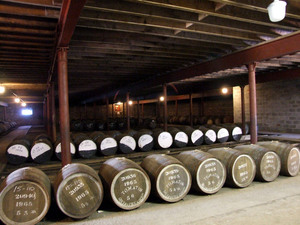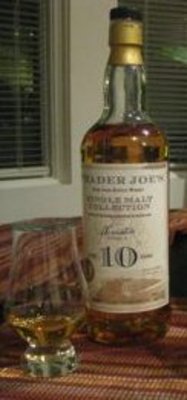|
|
Release Notes
A Trader Joe's bottling of 10 year old Tomatin.
Yours Truly
3rd Party Tasting Notes
Color: dull gold, that seems thin and reflective
Legs: large, really quick beads. they almost don't form - you just see the tails
Nose: some pear. woods, sweetness that's barely vanilla, candied apples.
Palette(sic): saccharin orange, the scotch burn. goes from wetness to harshness really quickly. a tinge of vanilla, but more of a cloying alcohol.
Finish: Cherries and some rubber. It's a little harsh, most of it ends quickly, though there's a lingering bitterness.
Overall: Hmmm. I have high hopes for these whiskies. I love that Trader Joe's does this. But this whisky was pretty underwhelming. The best part was the nose, and even after three small sips, my mouth is a little numb from the over-ripeness of the dram.
Score : 6.5/10
Legs: large, really quick beads. they almost don't form - you just see the tails
Nose: some pear. woods, sweetness that's barely vanilla, candied apples.
Palette(sic): saccharin orange, the scotch burn. goes from wetness to harshness really quickly. a tinge of vanilla, but more of a cloying alcohol.
Finish: Cherries and some rubber. It's a little harsh, most of it ends quickly, though there's a lingering bitterness.
Overall: Hmmm. I have high hopes for these whiskies. I love that Trader Joe's does this. But this whisky was pretty underwhelming. The best part was the nose, and even after three small sips, my mouth is a little numb from the over-ripeness of the dram.
Score : 6.5/10
WhiskyParty.net
The Bottler: Trader Joe"s
| Established: 1958 |
| Silent since: False |
| Address: 800 S Shamrock Ave, Monrovia, CA 91016-6346, USA |
| → website |
Trader Joe"s is named after its founder, Joe Coulombe. The chain began in 1958 as a Greater Los Angeles area chain of "Pronto Market" convenience stores. The original Pronto Markets were similar to 7-Eleven stores, so similar Coulombe felt the competition with 7-Eleven would be ruinous. He is said to have developed the idea of the Trader Joe South Seas motif while on vacation in the Caribbean. He had noticed that Americans were traveling more and returning home with tastes for food and wine they had trouble satisfying in supermarkets of the time. The first store named "Trader Joe"s" opened its doors in 1967. This store, on Arroyo Parkway in Pasadena, California, remains in operation. In response to competition from 7-Eleven, the chain differentiated its stores" offerings and doubled the floor space in 1967. In the first few decades of operation, some of the stores offered fresh meats provided by butchers who leased space in the stores. Trader Joe"s at one time had sandwich shops, freshly cut cheese, and fresh squeezed orange juice. Theo Albrecht bought the company in 1979. Coulombe was succeeded by John Shields in 1989. Shields retired in 2001, turning the reins over to Dan Bane. Shields still does consulting for the company.

Trader Joe"s is a privately held chain of specialty grocery stores headquartered in Monrovia, California. As of April 2010, Trader Joe"s had a total of 340 stores. Approximately half of its stores are in California, with the heaviest concentration in Southern California, but the company also has locations in 24 other states and Washington, D.C. Trader Joe"s was founded by Joe Coulombe and is currently owned by a family trust set up by German businessman Theo Albrecht, one of the two brothers behind the German supermarket chain Aldi.
Trivia:
- According to BusinessWeek, Trader Joe"s pays above-union wages and generous bonuses. It contributes an additional 15.4% of each worker"s gross pay into a company-funded retirement plan. As of 2004, pay for entry-level part-timers was $8 to $10 an hour; first-year supervisors average more than $40,000 a year.
- A Business Week article about the store noted that, between 1990 and 2001, the chain quintupled the store number and increased its profits by ten times. Supermarket News estimates that Trader Joe"s total sales for 2009 were $8 billion, which gave it a ranking of No. 21 on the list of "SN"s Top 75 Retailers for 2010."
- The May 2009 issue of Consumer Reports ranked Trader Joe"s the second-best supermarket chain in the nation, after Wegmans.
- In June 2009 MSN Money released its third annual Customer Service Hall of Fame survey results. Trader Joe"s ranks 2nd in customer service.
- Ethisphere Magazine named Trader Joe"s one of the most ethical companies in the United States in 2008, 2009, and 2010.
from Wikipedia
The Distillery: Tomatin
| Established: 1897 |
| Silent since: False |
| Address: Tomatin, Inverness, Inverness-Shire, IV13 7YT, Scotland |
While the Tomatin brand may have a fairly low profile on the shelves of liquorists around the world as a single malt, vast quantities of it were used in various blends like Antiquary and The Talisman. Measured by production capacity, Tomatin is one of the top 10 malt whisky distilleries in Scotland.
I didn"t bother enough to make precise calculations, but I imagine that almost twenty percent of the Scotch whisky industry is now in Asian hands. They seem to do quite well.
According to the Malt Whisky Yearbook 2008, the Tomatin distillery now produces circa two million litres of alcohol each year. That means they"re not even operating at half capacity - while the current capacity of five million litres is a mere shadow of the twelve million litres of alcohol they produced around 1974. Remember that this equals over twenty-five million bottles of (malt) whisky. Well, I guess that it"s no wonder that the 1970"s went by in a blurry haze for so many people ;-)
The Tomatin Distillery Company went into liquidation in 1985, but just one year later two Japanese customers came to the resque. In 1986 Takara Shuzo Co. and Okara & Co. bought the Tomatin distillery and became the first Japanese owners of a Scotch whisky distillery. I think that also made them the very first Asian owners...
In 1998 Takara Shuzo Co. (part of the Marubeni Group) acquires the shares of Okara & Co. and becomes the sole owner of the Tomatin Distillery Co. Ltd. By that time many more distilleries in Scotland were owned by Asian companies, including Bowmore, Glen Garioch, Auchentoshan, and Ben Nevis. After the Indian take-over of Whyte & Mackay in 2007, the list grew even longer.

The Tomatin distillery was founded in 1897 during the "whisky boom" of the late nineteenth century. The "Pattison Crisis" that followed the boom wiped out many distilleries, but Tomatin managed to struggle on for a few years before it went bankrupt in 1906. The Tomatin Distillery Co. Ltd. resumed production in 1909 and for half a century the history of Tomatin was fairly uneventful. Their single set of two stills was quietly bubbling away on the border of the Northern Highlands, Western Highlands and Speyside.
However, in 1956 things started to change for Tomatin. The number of stills was expanded from two to four - and then they added two more in 1958. And then the people of Tomatin started to think REALLY big. In 1961 they added four more stills, bringing the total to ten stills. But wait there"s more... In 1964 yet another still was added, making Tomatin (temporarily at least) one of only a few Scotch whisky distilleries with an uneven number of stills. By the time the maltings at Tomatin were closed in 1974, 23 stills were operating there. At the time, it was Scotland"s largest distillery, annually producing 12 million litres of alcohol.
The turbulent history of Tomatin is interesting for another reason - it was the first distillery in Scotland that used a novelty from the brewer"s world; the lauter mash tun. Traditional mash tuns used turning rakes to keep mixing the malted barley and the water. In the lauter mash tun these rakes were replaced by sharp knives, twisting and turning to help the extraction of soluble starch. While the guides at many distilleries have a folksy tale to tell about workers falling into a mash tun and refusing to come out, I think the lauter mash tun has put an end to that practice in real life...
The 10 years old official bottling used to be a favourite of mine in the 1990"s. It has since been replaced by a Tomatin 12yo expression shown above, while older official bottlings have become available as well. If you ask me, the design of the label of the 25yo makes it look like a bottle you might expect to find on the shelves of a brothel in the 1970"s, but there"s no accounting for bad taste I guess ;-) And looks aren"t everything; I prefer the new 12yo over the old 10yo.
2006 - The range is expanded with a 18yo official bottling, priced at circa 40,- GBP.

2008 - The range is expanded with a 30yo and a 40yo official bottling. Both are sold out pretty quickly.
That being said - I"ve had the pleasure of trying some very decent independent bottlings of Tomatin over the years. Perhaps the 25yo OB became a little too "vatted" and polished for my tastes.
In the new Millenium
2004 - The 12yo official bottling of Tomatin is launched in the UK and mainland Europe. It"s not the first OB of Tomatin at this age though; around the turn of the millennium a 12yo official bottling had been available in the USA. In the same year Tomatin starts with the part-time production of relatively lightly peated spirit (12 PPM) as well.
2005 - The range is expanded with a 25yo official bottling, priced at circa 60,- GBP.
Trivia:
- The altitude (elevation) of Tomatin distillery is circa 300 meters above sea level - according to Google Earth.
- In 2002, eleven of the original stills at Tomatin were removed and dismantled.
- Tomatin"s malt whisky is matured in two dunnage warehouses and thirteen racked warehouses.
- Tomatin is one of almost two dozen malt whisky distilleries that were founded over a century ago during the "whisky boom" of the late 19th century and which have managed to survive until this day. The other survivors include Aberfeldy, Ardmore, Aultmore, Balvenie, Benriach, Benromach, Bruichladdich, Bunnahabhain, Dalwhinnie, Dufftown, Glendullan, Glenfiddich, Glenrothes, Glentauchers, Knockandu, Knockdhu, Longmorn and Tamdhu.
- During the early 1970"s Tomatin was the malt whisky distillery with the largest production capacity in Scotland. During the second half of the 1970"s Tomatin had no less than 23 stills, producing 12,000,000 litres a year.
from Malt Madness
The Owner: Takara Shuzo
| Established: 1925 |
| Silent since: False |
| Address: 20 Naginatahoko-cho, Shijo-dori Karasuma, Higishi-iru, Shimogyo-ku,Kyoto 600-8688,Japan |
| → website |
Takara Shuzo has subsidiaries in the United States, China and the UK.
Takara and Tomatin distillery formed a business alliance in 1971 leading to a shared ownership of Tomatin in 1986 when Takara and Okara companies bought the distillery. Takara acquired Okara"s shares in 1998 and has been the sole owner of the distillery since.

Takara Shuzo produces, imports and sells Sake, Shochu, Whisky and Brandy, light flavored alcoholic drinks as well as alcohol-based seasonings.
Takara Shuzo was established in 1925 but its predecessors sake brewing business can be traced back to 1842. It and many of it"s related sister companies were integrated under the umbrella of TaKaRa Holdings in 2002.
from TakaraShuzo.co.jp, Malt Madness
The Owner: TaKaRa Holdings
| Established: 2002 |
| Silent since: False |
| Address: 20 Naginatahoko-cho, Shijo-dori Karasuma, Higishi-iru, Shimogyo-ku,Kyoto 600-8688, Japan |
| → website |
Takara Holdings includes a variety of businesses including the Tomatin distillery as well as a number of food, trading, biotech, biomedical, lab, printing and other businesses.

Takara Holdings was established in 2002 as a holding company for alcoholic beverage maker and importer Takara Shuzo and its various sister companies.
from TaKaRa.co.jp
